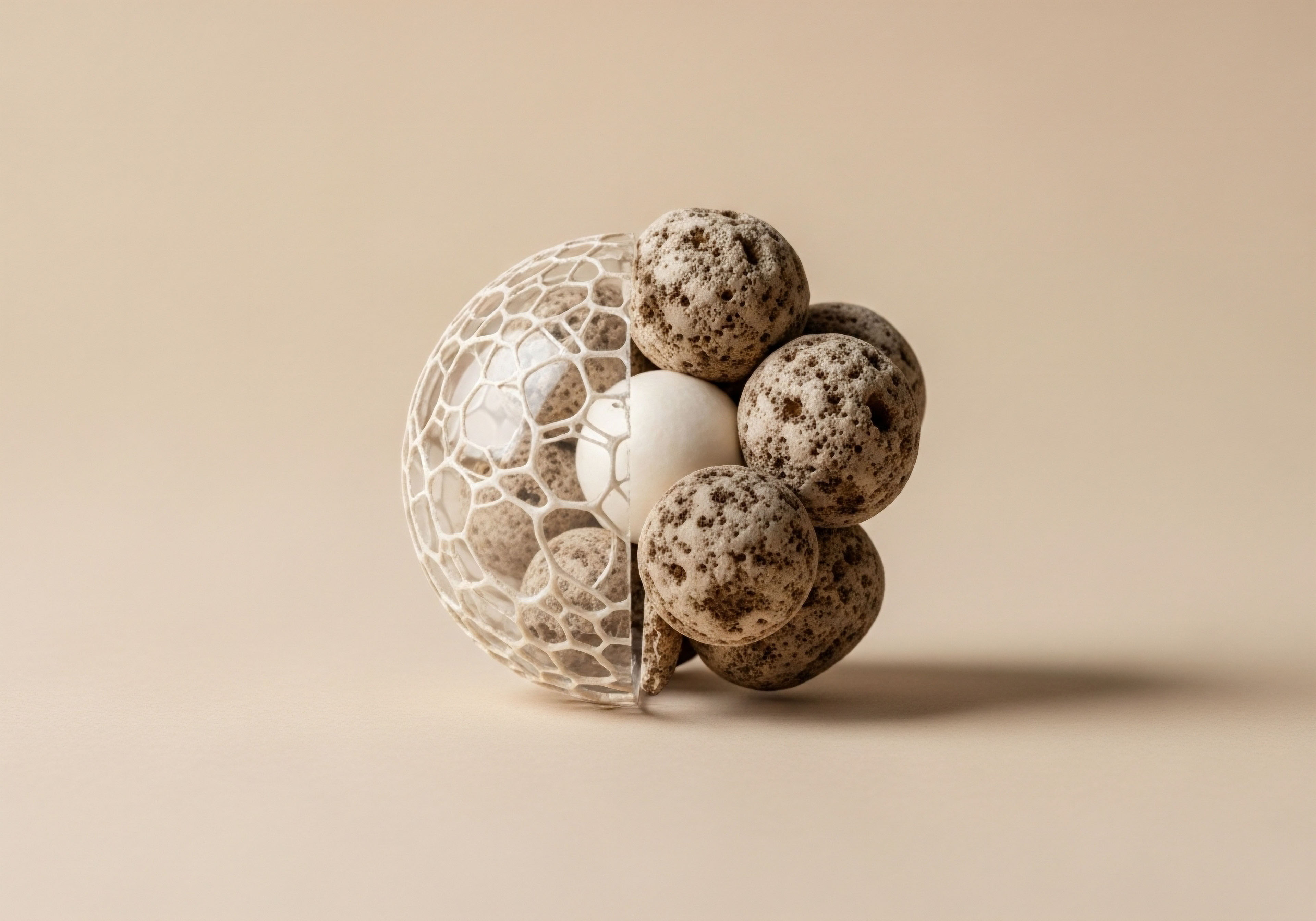

Fundamentals
You may have noticed changes in your skin over time ∞ a loss of firmness, a new network of fine lines, a dryness that no amount of moisturizer seems to quench. These shifts are often perceived as an inevitable consequence of aging, a story told on the surface of our skin.
This perspective, while common, is incomplete. Your skin is a meticulously orchestrated biological system, and its appearance is a direct reflection of your internal hormonal environment. The journey to understanding how to reclaim its vitality begins with acknowledging that these visible changes are signals from a deeper, systemic conversation happening within your body.
Hormone optimization protocols are designed to address the root causes of these changes at a cellular level. The decline in key hormones, particularly estrogen, progesterone, and testosterone, is a primary driver of what we perceive as skin aging.
These molecules are not merely reproductive messengers; they are fundamental regulators of skin health, influencing everything from hydration and structural integrity to repair mechanisms. When their levels diminish, the skin’s foundational support system begins to weaken. The experience of thinning, sagging, or wrinkled skin is the physical manifestation of a decrease in the production of collagen and elastin, proteins essential for skin’s firmness and resilience.
Hormonal shifts directly impact the skin’s structural proteins, leading to visible signs of aging like wrinkles and loss of elasticity.
Understanding this connection is the first step toward a new paradigm of personal wellness. It reframes the conversation from a passive acceptance of aging to a proactive engagement with your own physiology. The goal is to restore the biochemical balance that allows your skin, and indeed your entire body, to function optimally.
This process is about providing your cells with the necessary signals to rebuild, repair, and maintain their youthful function. It is a precise, science-driven approach to wellness that validates your experience by explaining the biological ‘why’ behind it.
The primary hormones involved in this process each play a distinct and crucial role:
- Estrogen is a master regulator of skin hydration and collagen production. It supports the skin’s ability to retain moisture by increasing the production of hyaluronic acid, a molecule that can hold many times its weight in water. Declining estrogen levels are directly linked to the dryness and loss of plumpness many women experience during perimenopause and menopause.
- Progesterone contributes to skin elasticity and helps to regulate oil production. Its decline can disrupt the skin’s natural balance, leading to either excessive dryness or other textural changes.
- Testosterone, while often associated with male physiology, is vital for both men and women in maintaining skin thickness and supporting collagen synthesis. A gradual decline in testosterone contributes to the thinning of the skin over time.
By addressing these hormonal deficiencies through carefully calibrated replacement therapy, we can directly influence the biological processes that govern skin quality. This is a journey of understanding your own body’s intricate systems and providing them with the support they need to function at their peak. It is a path toward reclaiming not just a more youthful appearance, but a deeper sense of vitality and well-being that radiates from within.


Intermediate
Moving beyond the foundational understanding that hormones influence skin, we can now examine the specific clinical protocols designed to leverage this connection for aesthetic and functional improvement. Hormonal optimization is a precise science, involving the careful administration of bioidentical hormones to replicate the body’s youthful signaling environment. These protocols are not a one-size-fits-all solution; they are tailored to the individual’s unique biochemistry, as revealed through comprehensive lab work and a thorough evaluation of symptoms.

The Core Triad of Hormonal Skin Support
The most effective protocols for improving skin quality typically focus on restoring optimal levels of three key hormones ∞ estrogen, progesterone, and testosterone. While each has its own specific benefits, their synergistic action provides a comprehensive approach to skin rejuvenation.

Estrogen the Master Hydrator and Collagen Synthesizer
Estrogen’s influence on the skin is profound and multifaceted. Clinically, estrogen replacement has been shown to increase skin thickness, improve hydration, and boost collagen production. Studies have demonstrated that women on hormone replacement therapy (HRT) experience a significant increase in collagen content, which directly translates to firmer, more elastic skin.
Estrogen achieves this by binding to specific receptors on fibroblasts, the cells responsible for producing collagen and elastin. This binding signals the cells to ramp up production, effectively counteracting the age-related decline. Furthermore, estrogen increases the synthesis of hyaluronic acid in the dermis, which enhances the skin’s ability to retain water, leading to improved hydration and a reduction in fine lines.

Progesterone the Elasticity Enhancer
Progesterone works in concert with estrogen to support skin health. While its mechanisms are still being fully elucidated, clinical evidence suggests that progesterone contributes to skin elasticity and firmness. Topical progesterone creams have been shown to improve skin elasticity and reduce wrinkles in postmenopausal women. By balancing the effects of estrogen and supporting the overall hormonal milieu, progesterone plays a vital role in maintaining the skin’s structural integrity.

Testosterone the Structural Support
In both men and women, testosterone is crucial for maintaining the skin’s structural framework. It contributes to skin thickness and supports the collagen matrix. For women, low-dose testosterone therapy, often administered as part of a comprehensive HRT plan, can yield significant benefits for skin quality, in addition to improving energy levels and libido.
For men undergoing Testosterone Replacement Therapy (TRT), improved skin tone and texture are often reported as ancillary benefits to the primary treatment goals. Research indicates a synergistic effect between estrogen and testosterone on skin collagen content, suggesting that a balanced approach is most effective.
Restoring hormonal balance through targeted therapies can directly increase the production of collagen, elastin, and hyaluronic acid, leading to measurable improvements in skin thickness, hydration, and elasticity.

Peptide Therapies a New Frontier in Skin Rejuvenation
In addition to traditional hormone replacement, peptide therapies represent a cutting-edge approach to stimulating the body’s own regenerative processes. Peptides are short chains of amino acids that act as signaling molecules, instructing cells to perform specific functions. Several peptides have shown remarkable promise in the realm of skin health.
The following table outlines some of the key peptides used in anti-aging and their primary benefits for the skin:
| Peptide | Primary Mechanism of Action | Key Benefits for Skin Quality |
|---|---|---|
| Sermorelin / CJC-1295 & Ipamorelin | Stimulates the pituitary gland to produce more of the body’s own Human Growth Hormone (HGH). | Improves skin elasticity, increases collagen synthesis, and enhances overall skin thickness and resilience. |
| BPC-157 | Promotes angiogenesis (the formation of new blood vessels) and has potent healing properties. | Accelerates wound healing, reduces inflammation, and supports the repair of damaged skin tissue. |
| Tesamorelin | A growth hormone-releasing hormone (GHRH) analog that stimulates HGH production. | Increases muscle mass and has been shown to improve body composition, which can indirectly support skin health by improving underlying structures. |
These peptides work by tapping into the body’s innate capacity for repair and regeneration. For instance, by increasing natural HGH levels, therapies involving Sermorelin or Ipamorelin can significantly enhance protein synthesis, which is essential for maintaining healthy skin and muscle tissue as we age. This approach is often considered a safer alternative to direct HGH administration, as it works with the body’s own regulatory feedback loops.

What Are the Clinical Protocols for Hormonal Optimization?
The specific protocols for hormone and peptide therapy are highly individualized. However, some common approaches include:
- For Women (Peri/Post-Menopausal) A combination of transdermal estrogen, oral or topical progesterone, and often a low dose of subcutaneous testosterone cypionate (e.g. 10-20 units weekly) is a common protocol. This balanced approach addresses the full spectrum of hormonal decline.
- For Men (Andropause/Low T) Testosterone Replacement Therapy, typically involving weekly intramuscular injections of Testosterone Cypionate, is the standard. This is often paired with medications like Gonadorelin to maintain natural hormonal function and Anastrozole to manage estrogen levels.
- Growth Hormone Peptide Therapy Peptides like CJC-1295/Ipamorelin are typically administered via subcutaneous injection 5-7 times per week, often before bedtime to mimic the body’s natural HGH release cycle.
By combining these advanced therapeutic strategies, it is possible to move beyond merely slowing the signs of aging and instead actively reverse some of the underlying biological processes. This represents a shift toward a model of proactive wellness, where the goal is to optimize function and enhance vitality from the inside out.


Academic
An in-depth examination of the mechanisms by which hormonal optimization improves skin quality requires a systems-biology perspective, focusing on the intricate interplay between the endocrine system and cutaneous physiology at the molecular level.
The visible attributes of youthful skin ∞ thickness, hydration, and elasticity ∞ are emergent properties of a complex network of cellular and extracellular processes that are profoundly regulated by steroid hormones and growth factors. The decline in these signaling molecules during aging initiates a cascade of deleterious changes in the skin’s structural and functional integrity.

The Role of Estrogen Receptor Signaling in Dermal Fibroblast Function
The primary mediators of estrogen’s effects on the skin are the estrogen receptors, ERα and ERβ, which are expressed in keratinocytes, melanocytes, and, most importantly, dermal fibroblasts. When estrogen (specifically 17β-estradiol) binds to these receptors, it initiates a signaling cascade that directly influences the expression of genes responsible for producing extracellular matrix (ECM) proteins.
Clinical studies have consistently demonstrated that estrogen administration increases the synthesis of type I and type III procollagen, the precursors to the skin’s main structural proteins. This upregulation is a key mechanism by which hormone replacement therapy combats the thinning of the dermis that occurs after menopause. After menopause, collagen content can decrease by as much as 30% in the first five years, a decline that is significantly mitigated by estrogen therapy.
The binding of estrogen to its receptors in dermal fibroblasts directly upregulates the transcription of genes for collagen and hyaluronic acid, leading to a thicker, more hydrated dermal matrix.
Furthermore, estrogen signaling enhances the production of glycosaminoglycans (GAGs), such as hyaluronic acid. This is achieved through the upregulation of hyaluronic acid synthase enzymes. The resulting increase in dermal hyaluronic acid content enhances the skin’s water-holding capacity, leading to improved turgor and a reduction in the appearance of fine lines. This mechanism explains the marked improvement in skin hydration often reported by individuals undergoing HRT.

Synergistic and Androgenic Influences on the Extracellular Matrix
While estrogen is a primary driver of skin health in women, testosterone also plays a crucial, albeit different, role. Androgen receptors are present in the skin, and testosterone has been shown to support skin thickness and collagen production. Some research suggests a synergistic effect when estrogen and testosterone are administered together, leading to a greater increase in skin collagen content than with estrogen alone. This underscores the importance of a balanced hormonal approach that considers the complete endocrine profile.
The following table provides a comparative analysis of the primary molecular actions of key hormones on the skin’s extracellular matrix:
| Hormone | Receptor Target | Primary Molecular Action | Resulting Phenotypic Change in Skin |
|---|---|---|---|
| Estrogen (17β-estradiol) | ERα, ERβ | Upregulates COL1A1, COL3A1, and HAS2 gene expression. | Increased collagen synthesis, increased hyaluronic acid, improved hydration and thickness. |
| Progesterone | PR-A, PR-B | Modulates matrix metalloproteinase (MMP) activity, potentially inhibiting collagen breakdown. | Contributes to skin elasticity and structural integrity. |
| Testosterone | AR | Supports sebaceous gland function and contributes to dermal thickness. | Maintains skin thickness and structural support. |

How Do Growth Hormone Peptides Influence Cutaneous Regeneration?
Growth hormone-releasing hormone (GHRH) analogues and growth hormone-releasing peptides (GHRPs) like Sermorelin, CJC-1295, and Ipamorelin, represent an advanced therapeutic modality that acts upstream of direct hormone administration. These peptides stimulate the endogenous pulsatile release of Human Growth Hormone (HGH) from the pituitary gland. HGH, in turn, stimulates the liver to produce Insulin-like Growth Factor 1 (IGF-1), a potent anabolic agent with significant effects on the skin.
IGF-1 receptors are abundant in the skin, and their activation promotes fibroblast proliferation and collagen synthesis. This pathway is critical for tissue repair and regeneration. By enhancing the natural HGH/IGF-1 axis, peptide therapies can improve skin elasticity and density.
Clinical studies on peptide complexes have shown significant improvements in facial wrinkles, which is attributed to the stimulation of basement membrane proteins and dermal collagen. This approach offers a powerful method for enhancing the skin’s intrinsic regenerative capacity, working in concert with direct hormonal support to achieve a comprehensive anti-aging effect at the cellular and molecular levels.

References
- Lephart, E. D. & Naftolin, F. (2021). Menopause and the Skin ∞ Old Favorites and New Innovations in Cosmeceuticals for Estrogen-Deficient Skin. Dermatology and Therapy, 11(1), 53 ∞ 69.
- Brincat, M. P. Baron, Y. M. & Galea, R. (2005). Estrogens and the skin. Climacteric, 8(2), 110-123.
- Rzepecki, A. K. Murase, J. E. Juran, R. Fabi, S. G. & McLellan, B. N. (2019). Estrogen-deficient skin ∞ The role of topical therapy. International Journal of Women’s Dermatology, 5(2), 85 ∞ 90.
- Thornton, M. J. (2013). Oestrogen functions in skin and skin appendages. Expert Opinion on Therapeutic Targets, 17(9), 1035-1046.
- Stevenson, S. & Thornton, J. (2007). Effect of estrogens on skin aging and the potential role of SERMs. Clinical Interventions in Aging, 2(3), 283 ∞ 297.
- Schmid, D. Zülli, F. & Berose, T. (2019). Anti-Wrinkle Benefits of Peptides Complex Stimulating Skin Basement Membrane Proteins Expression. Cosmetics, 6(4), 67.
- Verdier-Sévrain, S. & Bonte, F. (2007). Skin hydration ∞ a review on its molecular mechanisms. Journal of Cosmetic Dermatology, 6(2), 75-82.
- Callens, A. Vaillant, L. Lecomte, P. Berson, M. Gall, Y. & Lorette, G. (1996). Does hormonal skin aging exist? A study of the influence of different hormone replacement therapies on the skin of postmenopausal women. Dermatology, 193(4), 289-294.
- Sator, P. G. Schmidt, J. B. Rabe, T. & Zouboulis, C. C. (2004). Skin aging and sex hormones in women–clinical perspectives for intervention by hormone replacement therapy. Experimental Dermatology, 13 Suppl 4, 36-40.
- Hall, G. Phillips, T. J. & Runger, T. M. (2005). The influence of estrogens on skin aging. Journal of the American Academy of Dermatology, 53(4), 555-568.

Reflection
The information presented here provides a map of the biological territory, detailing the pathways and mechanisms that connect your internal state to your external appearance. This knowledge is a powerful tool, shifting the perspective from one of passive observation to one of active participation in your own health.
The journey of optimizing your well-being is deeply personal, and the data is just the starting point. How you feel, the vitality you experience, and the confidence you carry are the true measures of success.
Consider this exploration not as a conclusion, but as an invitation to begin a deeper conversation with your own body, guided by a new understanding of its intricate and elegant design. The potential for regeneration and vitality is already within you; the key is to unlock it.



